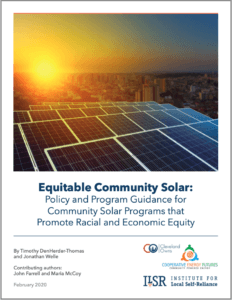Report: Designing Community Solar Programs That Promote Racial & Economic Equity
Originally published at ILSR.org
A collaborative report by Timothy DenHerder-Thomas (Cooperative Energy Futures) and Jonathan Welle (Cleveland Owns), with contributing authors John Farrell and Maria McCoy (Institute for Local Self-Reliance).
Key Links
- Download the Report
- Register for a webinar on the report, March 10th, 2020 at 12pm EST
- Report Press Release

Executive Summary
This white paper provides guidance for creating community solar programs that promote racial and economic equity.
It defines what makes a community solar program equitable, and states objectives that community solar programs striving to be equitable can pursue related to program structure, consumer participation, compensation, and other policy areas. For each objective, this paper recommends one or more high-level policy or program guideline designed to center marginalized communities, defined as “communities at the frontline of pollution and climate change (‘frontline communities’), and those historically and presently disenfranchised by racial, economic, and social inequity.”(1) It offers a rationale for each policy, while listing other plausible options that may work best in specific scenarios.
For example, this paper recommends using a system of adders to incentivize participation of marginalized communities and local community ownership of community solar arrays. It recommends that community solar programs provide on-bill credits, accommodate changes in address and energy use, and create a simple sign-up process. This paper describes a community solar program governance process that centers marginalized communities and promotes program transparency and adaptation.
While the research and findings in this paper apply to programs nationwide, in a case study of Cleveland, Ohio, this paper estimates that the construction phase of potential community solar programs of 10 megawatts (MW) and 50 MW would generate economic impacts of $21 million and $95 million, respectively, nearly twice the upfront construction costs.
This paper is intended for city elected officials and policymakers, administrators of municipal electric utilities (i.e., munis), and local advocates building equitable third-party or muni-owned community solar programs. It is most applicable to municipalities with a municipal electric utility or other lever that provides flexibility in sourcing energy, such as a Community Choice Aggregation entity. Much of this paper is relevant for policy makers and advocates designing regional or state-level community solar programs, as well.
- Subin DeVar, “Equitable Community Solar: California and Beyond,” Ecology Law Quarterly, forthcoming in 2020.
To read the rest, including policy and program guidance, an economic impact assessment, and conclusion, download a pdf of the report.
Acknowledgements
A special thanks to Gabriel Chan (University of Minnesota), Jill Cliburn (Cliburn and Associates), Subin DeVar (Sustainable Economies Law Center), Matthew Grimley (University of Minnesota), Gilbert Michaud (Ohio University), and Corey Ramsden (Solar United Neighbors) for their contributions to this paper.
This article originally posted at ilsr.org. For timely updates, follow John Farrell on Twitter, our energy work on Facebook, or sign up to get the Energy Democracy weekly update.
Have a tip for CleanTechnica? Want to advertise? Want to suggest a guest for our CleanTech Talk podcast? Contact us here.
Latest CleanTechnica.TV Video

CleanTechnica uses affiliate links. See our policy here.
